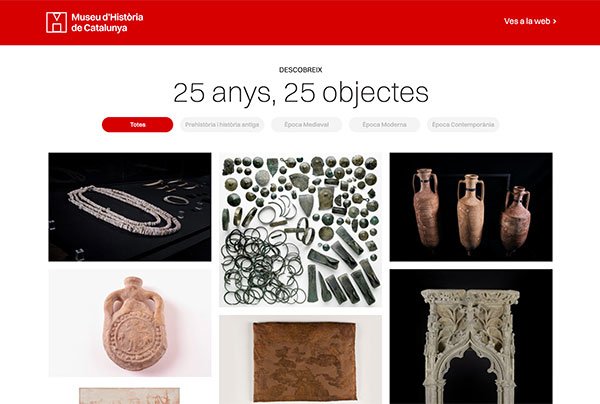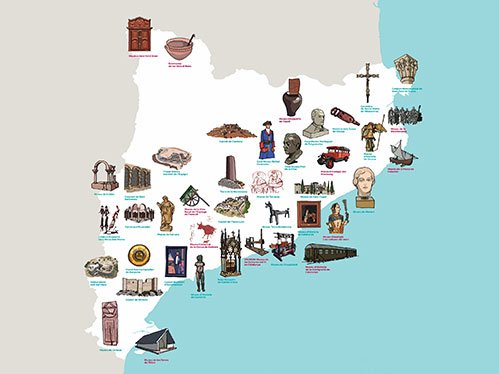Title: Rethinking E Pluribus Unum: the national museum and the plurality of discourses
Magdalena Mieri
In this presentation Magdalena Mieri of the Smithsonian Institution National Museum of American History in Washington DC will be talking about the challenges and opportunities involved in creating an inclusive historical narrative. Her lecture will invite the listeners to go on a journey through the history of the creation of the institution and the history museum from the point of view of the shaping of a identity marked by a progressive providentialism and a sense of freedom, justice and equality, which is not the same for everyone.
Over the years, waves of migration and academic and social movements affected the question of the national identity. Social changes in the sixties and seventies, backed by postcolonial theories, provided a new framework for study that made it possible to explain the differences, legitimised the multiplicity of visions and spurred the creation of a society based on coexistence and tolerance of differences. That opened up new fields of study, such as public history, American studies and ethnic studies, which have become part of the intellectual equipment of the new curators of the museum. That achieved a new awareness and, most of all, a criticism of the progressive providentialist myths that had made up the basis of national history.
She will explain the impact of those social changes on the identity of the “American” being and the range of historical interpretations and how those changes affect museological practice and the narrative presented at the museum.
It is estimated that by 2040 the majority of the population of the United States will belong to one of today’s racial minorities. What is the museum’s responsibility when it comes to assimilating those changes, which will undoubtedly affect the national identity? What tools and methods will enable us to assimilate that change? Those will be some of the questions that will invite the participants to think about the importance of nationalhistorymuseums today.
The role of national museus in modern society: challenges and problems in balkan context. The Case Study of the Museum of Rhe Macedonian Struggle – Skopje
Branislav Svetozarevikj
The Museum of the Macedonian Struggle – Skopje is history museum that covers the beginning of 19. Century until the end of 20. Century. This period reflects the history of the struggle and the efforts of numerous generations of Macedonian intellectuals and revolutionaries for creating contemporary Macedonian statehood and independence. Conceptually, with its 13 departments in total, the museum is divided into two smaller units: "Museum of the Internal Macedonian Revolutionary Organisation" and "Museum of victims of the communist regime".
The historical theme covered by this museum is not only the subject of research and presentation, but it has its own influence in the present time and direct or indirect reflection over the work of the museum. National history museums in Europe, and in particular in the newly formed states in the Balkans, are a real challenge for their founders and authors. This stems from the fact that the stories of these countries are very intertwined among them. In the past, they had a common history, but at the same time a history of conflicts, so the exhibitions setting often enters into a very sensitive zone of actuality and a zone of emotions.
The museum concept was prepared by series of experts from the field of history, museology, architecture, scenography and other fields of interests. It was based on several principles: 1. The principle of real presentation of facts; 2. Emphasizing affirmative events which had happened in the past, bringing closer people and nations, regardless of who and where have ruled those territories; 3. Avoiding black and white presentation of events and people; 4. Using state-of-the-art technologies and novelties in exhibitions, etc.
As a result of this approach in the period of the actual building of the museum, the public had various respond - from approval to negative criticism. However, after the official opening, things got much clearer for the public. The museum is one of the first in the region that displayed the right and the left political movements, external and internal factors, victories and defeats, heroes and anti-heroes, the concepts of independent state and the concepts of adjoining Macedonia to some of the neighboring states. Among 153 wax figures there are representatives of various nationalities who lived in Macedonia: Macedonians, Albanians, Serbs, Bulgarians, Jews, Turks, as well as key political figures from the region and the world from that historical period.
For its exhibition the museum acquired more than 2.000 original items purchased by the Government of the Republic of Macedonia from the citizens and collectors. Almost half of them were donation. This large number of donations indicates that the museum was approved and long waited by the citizens.
In the six years of operation, the museum has been visited by over 260.000 visitors and 70.000 additional visitors who have attended over 900 organised events outside the exhibition. The Museum of the Macedonian Struggle is awarded with several international recognitions for its work.
The transformation of the Historical Museum of the National Museum of Montenegro after regaining of independence and its influence in the establishment and promotion of the new national identity
Miloš Vukanović
The History Museum is one of four units of The National Museum of Montenegro. It is the most complex unit of the National Museum composing of 4 museums and 3 monuments. The permanent exhibition of the History Museum, of National Museum of Montenegro, opened in 1989, is probably the most significant contribution to post war museum practice in Montenegro. It is conceived to represent the very complexity of Montenegrin history from prehistory to contemporary era.
As the necessity for adaptation for the entire exhibition was always present, with the increasingly changing national narratives of the 90s. The great amount of time and resources for such a task weren’t available and the opportunity arose after the regaining of independence of Montenegro in 2006, and the creation of the new curator team in 2011.
This lecture will present the new permanent exhibition of the History Museum of Montenegro and how it defines the History museum of the National Museum. The mentioned exhibition was created using a new approach in dealing with controversial heritage as it included and depicts the most sensitive and disputed episodes of Montenegrin and regional history. I will elaborate on the methods used to explain multiple and rival historical perspectives on same events and means to present “difficult” and violent historical heritage in the always present atmosphere of intensive historical revisionism. Finally I will present the phases of transformation of the History Museum of Montenegro, in concept and narrative, and its role in the establishment of the new Montenegrin national identity.
An attempt to approach the suggested imatge
Asier Madarieta
The singular powers of the Basque territories in Spain in the field of management of the heritage grant Bizkaia, as part of the Basque Autonomous Community, special protagonism as the leading agent in investigation, conservation and dissemination of the cultural heritage. Responsibility for exercising those powers lies with Bizkaia Provincial Council, governing body of the historical territory.
That was the institution that in 1991 created the Euskal Herria Museum. Seen by some authors as an ethnographic museum and by others as affirming identity, it was refurbished and reopened in 2006. As its name indicates, the fundamental purpose was, and is, to provide a space to show and interpret aspects of Basque identity and it does so by paying special attention to the local institutional sphere based on the special legal code, a system of laws passed in the Modern Age and still operative today, not forgetting aspects of folklore, language, traditions or sport, all mentioned by authors as elements that identify a human group and differentiate it from the rest. The importance of the special legal code argument is also confirmed by the fact that the museum is located in a symbolic place for it: the town of Gernika.
The location, the name, the layout and features of the permanent exhibition or the fact that 70% of the activities on the annual programme are linked in some way to matters relating to the country, its folklore, history or sport, speak to us of a museum that works to disseminate the identity of the Basques. A study and analysis of those activities give an idea of how it performs its task, the aspects it works on and the public its activity is aimed at.
Thinking about various aspects related to the past, present and future of identity museums, we consider that their existence is necessary and perfectly possible, without having to resort to euphemisms related to denominations and contents which, if they came into being, would augur museums far removed from a reality they should belong to and facing an uncertain but definitely marginal future.
In order to guarantee their future, identity museums must be open to the new needs of the society they represent, go beyond a mere more or less felicitous exhibition of objects and explore new issues such as mindsets or processes of resilience, as well as incorporating multiculturalism as a formative element of identity. These are aspects that will make our museums useful tools for society today that transcend the process of liquefaction that some philosophers and thinkers seem to descry.
The norwegian Folk Museum in light of Norwegian identity and independence, yesterday and today
Geir Thomas Risåsen
To understand the important role the Norwegian Folk Museum have played for the Norwegian culture during the 20th century we have to look at the history of the nation. From 1380 to 1814 Norway was part of the Danish-Norwegian kingdom and was ruled from Copenhagen. In the spring of 1814 Norway declared its independence, wrote its constitution and elected a king. A few months later, Norway was forced into a new union, this time with Sweden. Finally, in 1905, Norway become a fully independent nation. From the mid-nineteenth century, Norwegians started to discover our own history and culture. The establishment of the Norwegian Folk Museum in 1894 was a part of this national identity project. The supposedly true “national heritage” was found in the isolated mountain and valley regions of Norway, and in many ways, this is still the image the Folk Museum presents to the public. Among the urban upper classes, the interest for peasant antiques, old timber buildings and folk costumes is still strong today, in the way we encounter it at the museum. But Norway has changed a lot since 1894, and therefore the way the Museum presents itself must also change in the way we present Norway today.
 Oraris
Oraris
 Localizacion
Localizacion
 Bilhetes
Bilhetes
 Tarifes
Tarifes




 Twitter
Twitter Facebook
Facebook